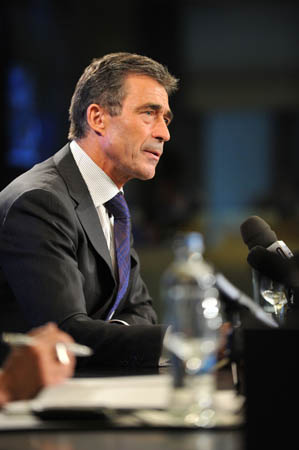NATO  Secretary General Anders Fogh Rasmussen called on the non-US alliance members to boost their arsenals of remotely piloted vehicles, overhead intelligence platforms, transports, and aerial refuelers in order to reduce the capability and capacity gap between the United States and them. Speaking at his monthly press briefing this week in Brussels, Rasmussen acknowledged it would be a “real challenge,” but said he was committed to finding “the solutions at the next NATO summit in Chicago” in May 2012. He said one likely scenario would be for members “to pool and share resources,” similar to the NATO-affiliated 12-nation Strategic Airlift Capability consortium that operates three C-17s out of Papa AB, Hungary. He wants the alliance partners to define “a comprehensive defense package that will contribute to making more efficient use” of resources. “That’s my ambition,” he said. Rassmussen’s call for the Europeans to step up and rely less on the United States echoed former Defense Secretary Robert Gates’ farewell remarks to the alliance in June. NATO-led operations in Libya have highlighted the disparity, with alliance members relying on US intelligence-surveillance-reconnaissance and aerial refueling assets because they simply don’t have them, or don’t have enough of them. (AFPS release) (Rasmussen transcript)
Secretary General Anders Fogh Rasmussen called on the non-US alliance members to boost their arsenals of remotely piloted vehicles, overhead intelligence platforms, transports, and aerial refuelers in order to reduce the capability and capacity gap between the United States and them. Speaking at his monthly press briefing this week in Brussels, Rasmussen acknowledged it would be a “real challenge,” but said he was committed to finding “the solutions at the next NATO summit in Chicago” in May 2012. He said one likely scenario would be for members “to pool and share resources,” similar to the NATO-affiliated 12-nation Strategic Airlift Capability consortium that operates three C-17s out of Papa AB, Hungary. He wants the alliance partners to define “a comprehensive defense package that will contribute to making more efficient use” of resources. “That’s my ambition,” he said. Rassmussen’s call for the Europeans to step up and rely less on the United States echoed former Defense Secretary Robert Gates’ farewell remarks to the alliance in June. NATO-led operations in Libya have highlighted the disparity, with alliance members relying on US intelligence-surveillance-reconnaissance and aerial refueling assets because they simply don’t have them, or don’t have enough of them. (AFPS release) (Rasmussen transcript)
As with previous stealth aircraft unveilings, the Air Force’s imagery of the F-47 Next-Generation Air Dominance fighter has been doctored to keep adversaries guessing about its true shaping and design philosophy.